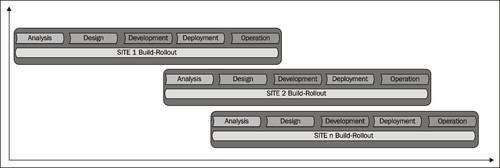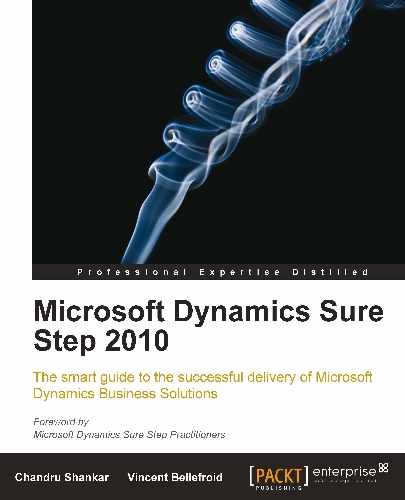In the previous sections, we have discussed the different options for implementing Microsoft Dynamics solutions using Sure Step. Sure Step has three waterfall project types (Rapid, Standard, and Enterprise), along with one Agile project type (Agile). These types guide the implementers through solution development and rollout of a single release, or to a single location of an organization. However, these project types can also be used in concert with each other, on phased solution rollouts or on multisite engagements, and this will be the focus of our discussion in this section.
In the previous chapter, we introduced the notion of the phased approach to solution delivery. This approach, not to be confused with the phases within a waterfall project type, refers to the rollout of the solution to the customer organization in multiple releases. The phased solution delivery approach is executed in practice by selecting and enabling an initial subset of solution functionality in the first release and then building on that with the help of additional features in subsequent releases. The alternative to a phased approach is delivering the full solution in a single release, also referred to as the big-bang approach to solution delivery, which we have already covered in the previous sections.
The Sure Step project types can be used together to facilitate the phased solution rollout. Essentially, each release is treated as a subproject, and the corresponding complexity of the requirements being enabled in each release will dictate the appropriate usage of the corresponding project type. The general concept of the phased solution rollout is depicted here:

Following this concept, the next diagram shows an example of its usage for an ERP solution implementation. In this diagram, Release 1 of the phased approach uses the Standard Project Type to enable the Finance Operations of the customer. This is followed by Release 2, using the Rapid Project Type, to deliver the Inventory Control and Order Fulfillment functionality. The last release, Release 3, uses the Agile Project Type to deploy Advance Planning and Scheduling functionality.

As you move into the larger organizational domains, the ERP/CRM solution requirements often transcend multiple locations for the customer. Multisite engagements can include both multiple sites in a single country and multiple locations around the world. The latter, of course, introduces far more complexity with country-specific requirements such as taxation and accounting rules. But in a majority of the cases, the customer's overarching objective is to deploy a common solution across all the sites.
To enable the development of a common solution across multiple locations, Sure Step provides the Core-Site Build Option with its Enterprise project type. In this approach, the service provider works with the customer to conduct Requirements Gathering Workshops, involving key Subject Matter Experts (SMEs) and Business Leads from all the relevant locations of the organization. The output of these workshops is a combined Functional Requirements Document (FRD) for the enterprise, which forms the basis for the "Core Build".
The Core Build can be viewed as a "common denominator solution". In the classic 80-20 rule, the Core Build will include functionality to support about 80% of the requirements of the enterprise. However, the Core Build is just a developed solution, meaning that it cannot be rolled out by itself. The Core Build is always deployed in conjunction with a Site Build that constitutes the functionality to meet the remaining 20% specific requirements of the corresponding site. The actual rollout at a given site can be staggered in time, or they can be rolled out with overlap—the timing itself is very topical and depends on the specific requirements being enabled for the enterprise.
The next diagram shows the Core-Site Build concept. The diagram shows one Core Build and subsequent Site Builds (Site 1 Build, Site 2 Build, Site n Build) and corresponding Site Rollouts (Site 1 Rollout, Site 2 Rollout, Site n Rollout).

In some cases, the customer may also have diverse set of companies within their portfolio, each of which has a very unique set of requirements, and so it is better to treat each of the sites as its own project. For these multisite instances, the Sure Step project types can be used in tandem, similar to the approach undertaken in the phased approach. An example of this scenario is shown in the next diagram. The diagram shows individual Site Builds and corresponding Site Rollouts (Site 1 Build-Rollout, Site 2 Build-Rollout, Site n Build-Rollout).

